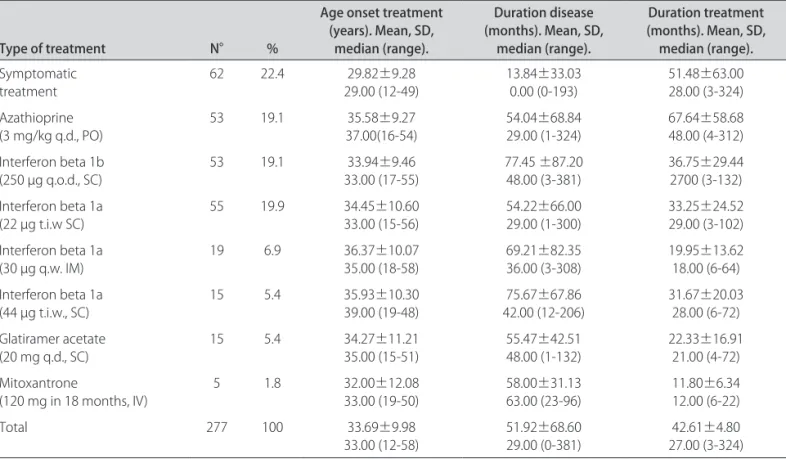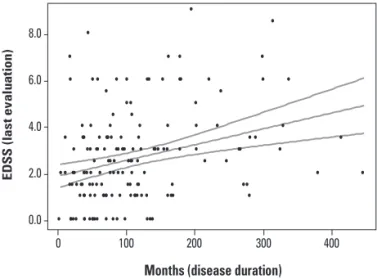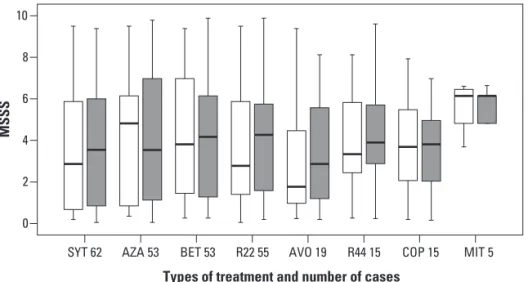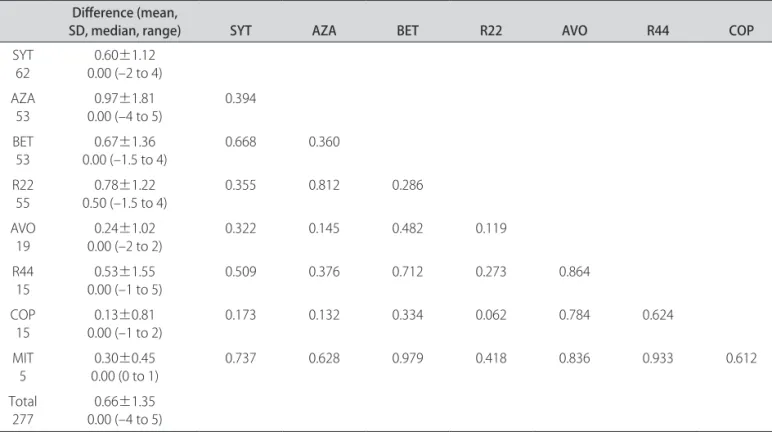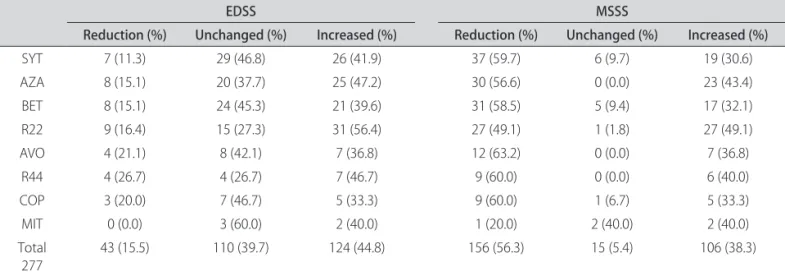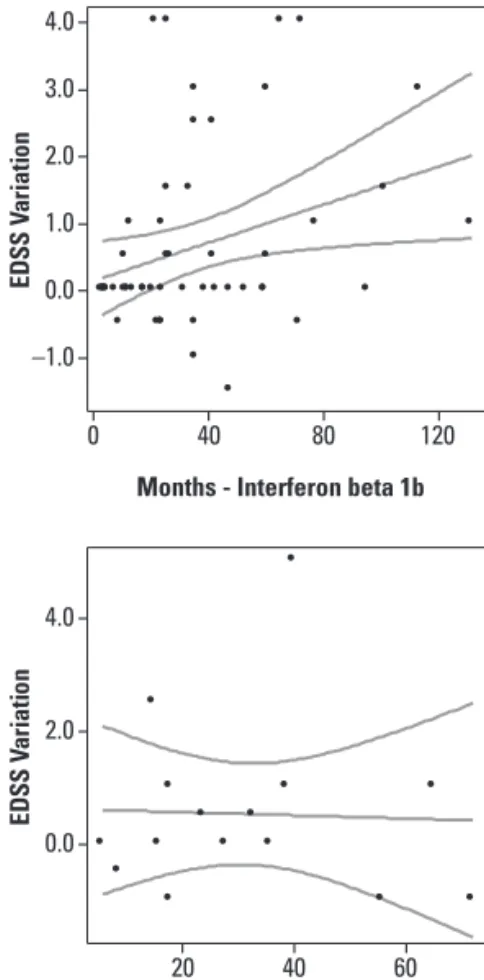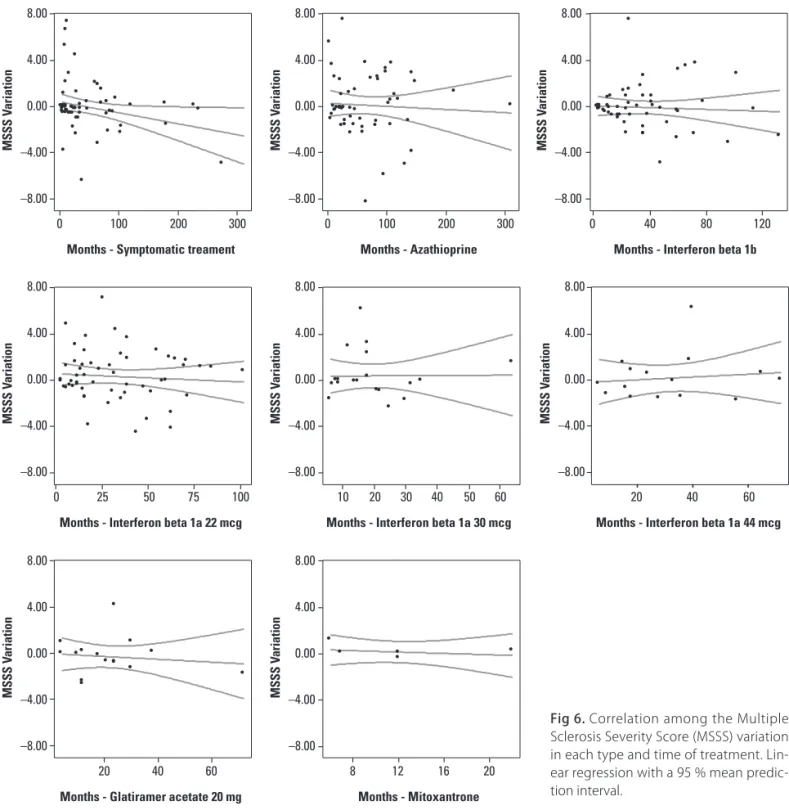Inluence of treatment in
multiple sclerosis dysability
An open, retrospective, non-randomized
long-term analysis
Lineu Cesar Werneck, Paulo José Lorenzoni, Vitor A. Radünz,
Marco A.T. Utiumi, Cláudia Suemi Kamoi Kay, Rosana Herminia Scola
ABSTRACT
The efficacies of immunosuppressive (IMS) and immunomodulatory (IMM) drugs for multiple sclerosis (MS) have been reported in several studies. These agents can reduce relapse rates and lesions observed by magnetic resonance imaging studies. However, the effect of these medications in disability progression over 4 years is rarely examined. Objective: To study the disabilities associated with MS patients after a long time period and to analyze the therapeutic influence of different types of treatments in patient disease progression. Method: This is an open, uncontrolled, non-randomized, retrospective study of the disease progression using the Expanded Disability Status Scale (EDSS) and the Multiple Sclerosis Severity Score (MSSS) in 155 cases of MS, which were 76% female with a mean age of onset of 30.21±9.70. The follow-up period was 115.39±88.08 months (median 92, 3 to 447 months). These cases were submitted to the following 277 different therapeutic procedures: 62 without IMS or IMM therapy (SYT) (just corticosteroids), 53 with azathioprine (AZA), 53 interferon-β (IFNβ)-1b 250 µg (BET), 55 IFNβ-1a 22 µg (R22), 19 IFNβ-1a 30 µg (AVO), 15 IFNβ-1a 44 µg (R44), 15 glatiramer acetate (COP) 20 mg, and 5 cases with mitoxantrone (MIT). Results: The median EDSS group was 2.00 (0 to 5.5, mean 1.89±1.52) at the onset of each treatment and 2.50 (0 to 9, mean 3.06±2.18) at the end. The median initial MSSS was 3.34 (0.25 to 9.50, mean 3.94±2.91) and the final medial was 3.90 (0.05 to 9.88, mean 4.02±2.78). The EDSS between initial and final score for the whole group had statistically significant progression, as well as for the sub-groups SYT, AZA, BET and R22. No statistically significance difference was found in the MSSS between initial and final scores in the whole group or treatment sub-groups. The variation between the initial and final EDSS and MSSS among the types of treatments found no statistical significance for any group. Conclusion: In this study series, no statistical difference was found in the long-term progression of disability among the IMS and IMM treated cases, nor in the cases treated only with corticosteroids.
Key words: multiple sclerosis, immunomodulatory therapy, immunosuppressive therapy, EDSS, multiple sclerosis disability, multiple sclerosis treatment.
Influência do tratamento na incapacidade da esclerose múltipla: estudo aberto, retrospectivo e não randomizado em longo prazo
RESUMO
A eficácia das medicações imunossupressivas (IMS) e imunomoduladoras (IMM) na esclerose múltipla (MS) tem sido relatada em diversos estudos. Essas medicações podem reduzir o número de surtos e de lesões observadas nos estudos de ressonância magnética. Entretanto, o efeito dessas medicações na progressão da incapacidade em período acima de quatro anos é raramente estudado. Objetivo: Estudar a incapacidade associada à MS em longo prazo e analisar os benefícios dos diferentes tipos de tratamento na progressão Correspondence
Lineu Cesar Werneck Serviço de Neurologia Hospital de Clínicas da UFPR Rua Gal. Carneiro 181 / Sala 310 80060-900 Curitiba PR - Brasil E-mail: werneck@ufpr.br
Support
This study is part of the research project in MS genomics funded by the CNPq (Brazilian National Research Council). No pharmaceutical industry gave any support to this study and it was design, conducts and analyzed by the authors
Conflicts of interest
Lineu Cesar Werneck received honoraria for speaking from Merck-Serono, Roche Pharmaceuticals and Boeringher-Ingelheim and research grant from Abbott-Biogen and TRB-Pharma. Rosana Herminia Scola received honoraria for consultation and speaking from Merck-Serono and research grant from Bayer-Schering. The other authors declare that they have no conflicts of interest
Received 27 November 2009 Received in final form 23 February 2010 Accepted 2 March 2010
da doença. Método: Estudo aberto e retrospectivo da progressão da incapacidade utilizando a escala expandida do grau de incapacidade (EDSS) e o escore da gravidade da esclerose múltipla (MSSS) em 155 casos de MS, sendo 76% do sexo feminino, idade média no início da doença 30,21±9,70 anos e período médio de seguimento 115,39±77,08, mediana 92 (3 a 447) meses. Os casos foram submetidos a 277 tipos diferentes de tratamentos: 62 casos não usaram IMS ou IMM, somente corticosteróides (SYT); 53 com azatioprina (AZA); 53 com interferon-β (IFNβ)-1b 250 µg (BET); 55 com IFNβ-1a 22 µg (R22); 19 com IFNβ-1a 30 µg (AVO); 15 com IFNβ-1a 44 µg (R44); 15 com acetato de glatiramer (COP) 20 mg, e 5 casos com mitoxantrone (MIT). Resultados: A mediana do EDSS do grupo foi 2,0 (0 a 5,5, média total do grupo foi 1,89±1,52) no início de cada tratamento e 2,50 (0 a 9, média de 3,06±2,18) no fim. A mediana inicial da MSSS foi 3,34 (0,25 a 9,50, média 3,94±2,91) e a final 3,90 (0,05 a 9,88, média 4,02±2,78). O EDSS entre o início e o fim do tratamento do grupo mostrou progressão estatisticamente significante e também para os subgrupos SYT, AZA, BET e R22. Não foi encontrada diferença estatística no MSSS entre o início e fim do tratamento no grupo total ou nos subgrupos. Não foi encontrada diferença estatisticamente significante entre a variação inicial e final do EDSS e MSSS entre os diversos subgrupos de tratamento. Conclusão: Nesta série, não foi encontrada diferença estatística na progressão da incapacidade em longo prazo entre os IMS e IMM, bem como nos casos tratados unicamente com corticosteróides.
Palavras-chave: esclerose múltipla, terapêutica imunomoduladora, terapêutica imunossu-pressiva, EDSS, incapacidade na esclerose múltipla, tratamento da esclerose múltipla.
he progressive disability in multiple sclerosis (MS) remains a therapeutic problem despite numerous medi-cations available. In attempt to interfere with the natural course of this disease, which is marked by inlammatory and immunological abnormalities, immunosuppressive (IMS) drugs have been used for its treatment. One of the irst IMS drugs used was azathioprine (AZA), which was given orally at 3 mg/kg q.o.d. However, in relation to pla-cebo, this drug only showed modest efectiveness in fol-low up periods ranging between 1.5 and 3 years1-4. More
recently, the intravenous use of mitoxantrone (MIT) giv-en at 120 mg IV for 18 months showed efectivgiv-eness in follow up periods between 2 and 5 years. However, MIT has been reserved for cases that do not respond to immu-nomodulator (IMM) drugs because of its toxicity5,6.
In the last decade, IMM drugs have been introduced for the treatment of relapsing-remitting forms of MS, and several studies have been done to study their efective-ness. Most of these studies reported a reduction in the number of MS relapses over a follow-up period of two to three years as criteria for drug efectiveness7. he main
studies compared the test compound versus placebo or another drug, such as interferon beta (IFNβ) –1b 250 µg q.o.d., SC (BET)8, IFNβ-1a 30 µg q.w., IM (AVO)9-11,
IFNβ-1a 22 µg (R22) and 44 µg SC t.i.w. (R44)12, AVO and
R4413,14, BET and AVO15, glatiramer acetate 20 mg q.d. SC
(COP)16, R44 and COP17, or, BET and COP18.
Additional criteria often used to demonstrate the ef-fectiveness of these medications have included the reduc-tion of inlammatory activity or newly visible MRI lesions
in relation to the placebo group19, BET20, R2221, COP22,
AZA23 or MIT6 groups.
Regarding the progression of MS associated disability; most studies have reported little change in the Expanded Disability Status Scale (EDSS)8,24 or reduced disease
pro-gression compared with placebo groups9-16,25. In addition,
some studies have attempted to assess MS associated dis-abilities for longer periods (4 years), but results is diicult to analyze because the participating patients decreased progressively over the follow up period26,27. A study
us-ing only the placebo arm from 31 diferent randomized trials failed to validate any efects on disease progression because the follow up time was too short and/or the ef-fects on disease disability were too small to obtain a re-liable result28.
Over the natural course of the disease, MS patients evolve from relapsing-remitting forms to secondary pro-gressive forms, when numbers of relapses tend to reduce or disappear with an apparent reduction in disease activ-ity, thereby resulting in variable disease progression and apparent stabilization29. More recently, a new score was
developed based on the initial EDSS score and the time of disease progression for each patient. his was called Multiple Sclerosis Severity Score (MSSS) and was devel-oped from a data collection of 9,982 patients, comparing the EDSS of on individual with the disability distribution score in cases with similar disease duration30.
Univer-sity Medical Center and were retrospectively examined to determine whether some types of therapy used to treat MS inluenced the degree of disability progression using the EDSS and MSSS.
METHOD
We retrospectively review all the 247 patients charts with the diagnosis of MS seen in our hospital. To include patients in the study, they must have met the following in-clusion criteria: records with complete clinical and labora-tory data information regarding disease evolution, EDSS24
grade registered in the record during the clinical visit or data to enable proper analysis of the EDSS before 1997 (when the study began), a disease evolution compatible with MS diagnosis, a MRI consistent with MS, relaps-ing-remitting MS as initial form, an initial EDSS ≤ 5.5, and continuous treatment with the same drug for at least for 3 months. he following exclusion criteria were im-plemented: records with incomplete or conlicting data, primary progressive form, clinically isolated syndrome, neuromyelitis optica, lack of a thorough clinical investi-gation to rule out diseases that mimic MS and two drugs used simultaneously.
A group of patients who did not receive IMM or IMS drugs was included in this study and was called the symp-tomatic treatment (SYT) group. his SYT group includ-ed newly diagnosinclud-ed cases that had experiencinclud-ed a remis-sion in clinical symptoms, a good therapeutic response to
prednisone or methylprednisolone during relapses, a long interval between the second and third relapse, or side ef-fects from other medications (of IMS or IMM more than three months to be included in this group), or were from a period before the availability of IMM drugs or refused to use prescribed medications.
Relapses were treated in a subgroup of patients by cor-ticosteroid administration, which took the form of either intravenous methylprednisolone (pulse therapy) or oral prednisone. hese treatments were used for at least 30 days and then discontinued in the following months with an improvement of symptoms. hese drugs were not con-sidered as a unique treatment group, because steroid ad-ministration was used in all groups during exacerbation.
We evaluated 247 records, but 92 patients were ex-cluded because their records were incomplete and it was not possible to assess the development of MS associated disabilities and therapies used. We included only 155 pa-tients with a MS diagnosis who used 277 diferent thera-peutic procedures for their treatment. here was no spe-cific protocol to introduce the medication, usually af-ter the patient meets the diagnostic criaf-teria. he choose of medication changes from drug availability, introduc-tion of new drugs in the market, Government supplied or preference for one of the several physicians in charge of patients over the years. After the introduction of one type of medication, it was changed if the patient had two or more relapses per year and showed progression in disease
Table 1. Types of treatment, age, duration of disease for 155 cases of multiple sclerosis with 277 diferent therapeutic procedures.
Type of treatment N° %
Age onset treatment (years). Mean, SD,
median (range).
Duration disease (months). Mean, SD,
median (range).
Duration treatment (months). Mean, SD, median (range).
Symptomatic
treatment 62 22.4 29.00 (12-49)29.82±9.28 13.84±33.030.00 (0-193) 51.48±63.0028.00 (3-324)
Azathioprine (3 mg/kg q.d., PO)
53 19.1 35.58±9.27
37.00(16-54)
54.04±68.84 29.00 (1-324)
67.64±58.68 48.00 (4-312) Interferon beta 1b
(250 µg q.o.d., SC) 53 19.1 33.00 (17-55)33.94±9.46 77.45 ±87.2048.00 (3-381) 36.75±29.442700 (3-132)
Interferon beta 1a (22 µg t.i.w SC)
55 19.9 34.45±10.60
33.00 (15-56)
54.22±66.00 29.00 (1-300)
33.25±24.52 29.00 (3-102) Interferon beta 1a
(30 µg q.w. IM) 19 6.9 36.37±10.0735.00 (18-58) 69.21±82.3536.00 (3-308) 19.95±13.6218.00 (6-64)
Interferon beta 1a (44 µg t.i.w., SC)
15 5.4 35.93±10.30
39.00 (19-48)
75.67±67.86 42.00 (12-206)
31.67±20.03 28.00 (6-72) Glatiramer acetate
(20 mg q.d., SC) 15 5.4 34.27±11.2135.00 (15-51) 55.47±42.5148.00 (1-132) 22.33±16.9121.00 (4-72)
Mitoxantrone
(120 mg in 18 months, IV)
5 1.8 32.00±12.08
33.00 (19-50)
58.00±31.13 63.00 (23-96)
11.80±6.34 12.00 (6-22)
Total 277 100 33.69±9.98
disability (an irreversible increase more than one point in the EDSS over 6 months period) or adverse drug efects.
he sample consisted of 155 patients (118 female and 37 male) with an age onset ranging from 12 to 55 years (median 29.00, mean 30.21±9.70), and there was a pre-dominance of young female patients in this series. he time of follow-up varied between 3 to 447 months (me-dian 92, with a mean of 115.39±88.08 months).
Eligible patients were separated into eight groups (SYT, AZA, MIT, AVO, R22, R44, BET and COP) accord-ing to the time they remained in the same type of treat-ment (Table 1).
If the patients changed the treatment type, only the time period when they remained in the original treatment group was considered for analysis. In the new treatment group, the patient was considered as a new patient and the evaluation was from the beginning of the treatment to the time the patient remained in this new group. Some patients received two or more types of one treatment at different times, but were excluded if they had therapy combinations (two types of treatment at the same time). No overlap of treatment was allowed and if occurred, the case was excluded from the study. Relevant data included the age at onset, gender, clinical evaluation, time of dis-ease progression, initial EDSS score (at treatment type onset), inal EDSS score (evaluation at end of type treat-ment), time of the treatment, and modality of treatment (SYT, AZA, BET, R22, AVO, R44, COP and MIT). All the patients received the same amount of medication despite the age, gender, weight and disease duration (Table 1).
Also, using the EDSS and know disease duration, we classiied each patient in the multiple sclerosis severity score (MSSS), using the spread-sheet described by Rox-burg et al.30.
he data were analyzed using descriptive statistical methods such as the Student “t” test, Pearson’s correlation, Mann-Whitney U test and Wilcoxon signed ranks test.
RESULTS
he median initial EDSS of the 155 cases was 2.00 (0 to 5.5) and the mean was 1.89±1.52, and the inal medi-an was 2.50 (0 to 9.0) with memedi-an of 3.06±2.18. he me-dian initial MSSS was 3.34 (0.25 to 9.50) with the mean of 3.94±2.91, and the inal median was 3.90 (0.05 to 9.88) with the mean 4.02±2.78. he correlation (Pearson) be-tween the inal EDSS and time of disease progression for the whole group was 0.373 (p<0.01) (Fig 1) and for the i-nal MSSS was –0.035 (p=0.664) (Fig 2). During the fol-low-up, 78 cases had only one treatment type (SYT 7 es, AZA 20 cases, BET 22 cases, R22 20 cases, AVO 2 es, R44 4 cases, COP 3 cases), and the remaining 77 cas-es had two or more typcas-es of treatment at diferent timcas-es, but never at the same time (52 cases with two treatment
types, 18 cases with three treatment types, 7 cases with 4 treatment types and 1 case with ive treatment types). he number of patients who had received AZA, R22, BET and SYT was greater than those treated by AVO, R44, COP and MIT (Table 1).
he age of treatment onset among the diferent groups was statiscally signiicant between the SYT group and the AZA (p=0.002), BET (p=0.021), R22 (p=0.015), AVO (p=0.014) and R44 (p=0.034) groups (Mann-Whitney U test, p<0.05). However, the age of treatment onset be-tween AZA, BET, R22, AVO, R44, COP and MIT groups was not statiscally signiicant.
A statistically significant difference occurred with the time of disease progression before the treatment be-tween the SYT group and AZA (p=0.002), BET (p=0.021), R22 (p=0.015), AVO (p=0.014) R44 (p=0.034) and COP (p=0.170) on Mann-Whitney U test.
he AZA group had the longest time of use, followed by the SYT group, whereas the AVO and MIT groups
8.0
6.0
4.0
2.0
0.0
0 100 200 300 400
Months (disease duration)
ED
S
S
(l
as
t
ev
a
lu
ati
on)
Fig 1. Linear regression of all 155 cases between disease duration (months) and the expanded disability status scale (EDSS) upon i-nal evaluation with a 95% mean prediction interval.
10.0
7.5
5.0
2.5
0.0
0 100 200 300 400
M
S
S
S (l
as
t
ev
a
lu
ati
on)
Months (disease duration)
used the drug for the least amount of time (Table 1). here was statistical diference between the times of treatment in the SYT and AZA (p=0.013), AVO (p=0.048) and MIT (p=0.026) groups, and between AZA and all other drugs (BET p=0.003, R22 p=0.001, AVO p=0.000, R44 p=0.024, COP p=0.001, MIT p=0.001). Also, there were statisti-cal diferences in the time of use between BET with AVO (p=0.019) and MIT (0.023), as well as between MIT with R22 (p=0.037 and R44 (p=0.019) (Mann-Whitney U test).
he initial mean treatment EDSS score was statiscally signiicant between the SYT group and AZA (p=0.006), BET (p=0.003), R44 (p=0.028) or MIT (p=0.021) groups, which had higher EDSS (Mann-Whitney U test).
The comparison between mean and median initial and inal EDSS score for the whole group was statiscally
signiicant (p=0.000), as well as for the sub-groups SYT, AZA, BET and R22. No statistical signiicance was found in the sub-groups of AVO, R44, COP and MIT between the initial and inal evaluation (Fig 3).
When the disability between the initial and inal scores was compared using the MSSS, no statistical diference was found for the whole group as well for the treatment sub-groups (Fig 4).
When the diferences between initial and inal EDSS and MSSS score were compared between the groups, we found no statistical signiicance diference between any groups (including the SYT group) (Mann-Whitney U test, Tables 2 and 3).
he diference from the initial and inal EDSS score had statistical correlation with time of disease
progres-Fig 3. Initial and inal EDSS for 277 dif-ferent therapeutic procedures in mul-tiple sclerosis patients. Box represents the interquartile range, containing 50% of individual patient EDSS; whiskers lines points to the highest and lowest values, excluding outliers; lines across the box show medial values.
Types of treatment and number of cases
MIT 5 COP 15 R44 15
AVO 19 R22 55
BET 53 AZA 53
SYT 62
EDSS
10
8
6
4
2
0
Final Initial
EDSS: expanded disability status scale; SYT: symptomatic treatment; AZA: Azathioprine 3 mg/kg q.d., PO; BET: interferon beta 1b 250 µg q.o.d., SC; R22: interferon beta 1a 22 µg t.i.w., SC; AVO: interferon beta 1a 30 µg q.w., IM; R44: interferon beta 1a 44 µg t.i.w., SC; COP: glatiramer acetate 20 mg q.d., SC; MIT: mitoxantrone 120 mg in 18 months, IV; *p<0.001; Wilcoxon Signed Ranks Test; •: outliers.
Types of treatment and number of cases
MIT 5 COP 15 R44 15
AVO 19 R22 55
BET 53 AZA 53
SYT 62
MSSS
10
8
6
4
2
0
Final Initial
MSSS: multiple sclerosis severity score; SYT: symptomatic treatment; AZA: Azathioprine 3 mg/kg q.d., PO; BET: interferon beta 1b 250 µg q.o.d., SC; R22: interferon beta 1a 22 µg t.i.w., SC; AVO: interferon beta 1a 30 µg q.w., IM; R44: interferon beta 1a 44 µg t.i.w., SC; COP: glatiramer acetate 20 mg q.d., SC; MIT: mitoxantrone 120 mg in 18 months, IV. Wilcoxon Signed Ranks Test.
Table 2. Diference between the initial and inal EDSS among the types of treatments for 277 diferent therapeutic procedures in multiple sclerosis patients and statistical signiicance between the types of treatment.
Diference (mean,
SD, median, range) SYT AZA BET R22 AVO R44 COP
SYT
62 0.00 (–2 to 4)0.60±1.12
AZA 53
0.97±1.81 0.00 (–4 to 5)
0.394
BET
53 0.00 (–1.5 to 4)0.67±1.36 0.668 0.360
R22
55 0.50 (–1.5 to 4)0.78±1.22 0.355 0.812 0.286
AVO 19
0.24±1.02 0.00 (–2 to 2)
0.322 0.145 0.482 0.119
R44
15 0.00 (–1 to 5)0.53±1.55 0.509 0.376 0.712 0.273 0.864
COP
15 0.00 (–1 to 2)0.13±0.81 0.173 0.132 0.334 0.062 0.784 0.624
MIT 5
0.30±0.45 0.00 (0 to 1)
0.737 0.628 0.979 0.418 0.836 0.933 0.612
Total 277
0.66±1.35 0.00 (–4 to 5)
EDSS: expanded disability status scale; SYT: symptomatic treatment; AZA: Azathioprine 3 mg/kg q.d., PO; BET: interferon beta 1b 250 µg q.o.d., SC; R22: interferon beta 1a 22 µg t.i.w., SC; AVO: interferon beta 1a 30 µg q.w., IM; R44: interferon beta 1a 44 µg t.i.w., SC; COP: glatiramer acetate 20 mg q.d., SC; MIT: mitoxantrone 120 mg in 18 months, IV. Bold numbers: p<0.05 (Mann-Whitney U test).
Table 3. Diference between the initial and inal MSSS among the types of treatments for 277 diferent therapeutic procedures in multiple sclerosis patients and statistical signiicance between the types of treatment.
Diference (mean, SD, median,
maximum-minimum) SYT AZA BET R22 AVO R44 COP
SYT
62 –0.22 (–6.68-7.31)–0.07±2.19
AZA
53 –0.18 (–8.37- 7.47)0.09±2.70 0.619
BET
53 –0.24 (–4.96-7.47)0.10±1.97 0.866 0.555
R22
55 0.00 (–4.59-7.09)0.34±2.20 0.228 0.585 0.198
AVO
19 –0.14 (–2.40-6.14)0.39±2.04 0.590 0.730 0.553 0.837
R44 15
0.17±2.03 –0.14 (–1.78-6.24)
0.906 0.916 0.829 0.427 0.791
COP 15
–0.29±1.64 –0.15 (–2.69-4.15)
0.604 0.590 0.840 0.194 0.498 0.602
MIT 5
0.17±0.59 0.00 (–0.47-1.13)
0.229 0.702 0.340 0.979 0.526 0.542 0.229
Total 277
0.07±2.19 –0.15 (–8.37-7.47)
sion in months for the whole group of treatment, as well as for the sub-groups AZA and BET (Pearson’s correla-tion r test, Table 4 and Fig 5). However, with the MSSS the only group who had a statistical signiicance was the SYT sub-group (Table 4 and Fig 6).
he variation between the initial and inal EDSS scores showed a reduction in 43 patients (15.5%), no change in 110 (39.7%), and an increase in 124 (44.8%) (Table 5).
When with the use of the MSSS, we found a reduction in 156 (56.3%) cases, unchanged in 15 (5.4%) and increased in 106 (38.3%) (Table 5)
DISCUSSION
his series presents demographic and clinical char-acteristics similar to those already published. he inal EDSS score showed variation for the reduction of
disabil-Table 4. Correlation of diferences from EDSS and MSSS (initial and inal) with time of progression in months for 277 diferent therapeutic procedures in multiple sclerosis patients.
Diference EDSS/
Time of treatment p=* Time of treatmentDiference MSSS/ p=*
SYT
62 0.244 0.056 –0.274 0.031
AZA
53 0.440 0.001 –0.59 0.674
BET
53 0.305 0.026 –0.59 0.676
R22
55 0.258 0.057 –0.77 0.576
AVO 19
0.107 0.663 0.10 0.967
R44 15
–0.036 0.898 0.120 0.670
COP 15
–0.087 0.759 –0.127 0.652
MIT 5
–0.238 0.700 –0.322 0.597
Total 277
0.203 0.001 –0.116 0.054
EDSS: expanded disability status scale; MSSS: multiple sclerosis severity score; p: statistical signiicance; SYT: symptomatic treatment; AZA: Azathioprine 3 mg/kg q.d., PO; BET: interferon beta 1b 250 µg q.o.d., SC; R22: interferon beta 1a 22 µg t.i.w., SC; AVO: interferon beta 1a 30 µg q.w., IM; R44: interferon beta 1a 44 µg t.i.w., SC; COP: glatiramer acetate 20 mg q.d., SC; MIT: mitoxantrone 120 mg in 18 months, IV. Bold numbers: p< 0.05. (Pearson correlation r test).
Table 5. Variation in initial and inal EDSS and MSSS for 277 diferent therapeutic procedures in multiple sclerosis patients.
EDSS MSSS
Reduction (%) Unchanged (%) Increased (%) Reduction (%) Unchanged (%) Increased (%)
SYT 7 (11.3) 29 (46.8) 26 (41.9) 37 (59.7) 6 (9.7) 19 (30.6)
AZA 8 (15.1) 20 (37.7) 25 (47.2) 30 (56.6) 0 (0.0) 23 (43.4)
BET 8 (15.1) 24 (45.3) 21 (39.6) 31 (58.5) 5 (9.4) 17 (32.1)
R22 9 (16.4) 15 (27.3) 31 (56.4) 27 (49.1) 1 (1.8) 27 (49.1)
AVO 4 (21.1) 8 (42.1) 7 (36.8) 12 (63.2) 0 (0.0) 7 (36.8)
R44 4 (26.7) 4 (26.7) 7 (46.7) 9 (60.0) 0 (0.0) 6 (40.0)
COP 3 (20.0) 7 (46.7) 5 (33.3) 9 (60.0) 1 (6.7) 5 (33.3)
MIT 0 (0.0) 3 (60.0) 2 (40.0) 1 (20.0) 2 (40.0) 2 (40.0)
Total
277 43 (15.5) 110 (39.7) 124 (44.8) 156 (56.3) 15 (5.4) 106 (38.3)
0 100 200 300
Months - Symptomatic treament
0 100 200 300
Months - Azathioprine
0 40 80 120
Months - Interferon beta 1b
0 25 50 75 100
Months - Interferon beta 1a 22 mcg
10 20 30 40 50 60
Months - Interferon beta 1a 30 mcg
20 40 60
Months - Glatiramer acetate 20 mg
8 12 16 20
Months - Mitoxantrone
20 40 60
Months - Interferon beta 1a 44 mcg
4.0
2.0
0.0
–2.0
5.0
2.5
0.0
–2.5
4.0
3.0
2.0
1.0
0.0
–1.0
4.0
3.0
2.0
1.0
0.0
–1.0
2.0
1.0
0.0
–1.0
–2.0
2.0
1.0
0.0
–1.0
1.0
0.0
–1.0
4.0
2.0
0.0
ED
S
S
V
ari
ati
on
ED
S
S
V
ari
ati
on
ED
S
S
V
ari
ati
on
ED
S
S
V
ari
ati
on
ED
S
S
V
ari
ati
on
ED
S
S
V
ari
ati
on
ED
S
S
V
ari
ati
on
ED
S
S
V
ari
ati
on
Fig 5. Correlation among the Expanded Disability Status Scale (EDSS) variation in each type and time of treatment. Lin-ear regression with a 95% mean predic-tion interval.
ity up to four points and increased until ive points, and a similar variation occurred with several IMM drugs7.
We had an asymmetry of treatment groups regard-ing the number of patients because some drugs had been made available later for general use. he time spent ex-hibiting the irst symptoms and seeking medical help was variable for these SYT patients, which was partially due to the fact that they did not have residual neurological deicits or additional relapses. Some of these patients ceived treatment with corticosteroids during their MS re-lapse and presented with a complete clinical remission or minimal residual neurological deicits. his is probably
the reason these individuals remained in the SYT group for several years. Also, we should remember that corti-costeroids also have an IMS and anti-inlammatory efect, promoting the regulation of T cells, acting in the blood-brain barrier, the microglia and T-cell apoptosis, chang-ing the natural course of the disease31-35.
maintained with AZA. Also the initial mean EDSS score was lower in the SYT group because the majority of pa-tients were in the early stage of disease.
he lack of statistical diference between initial and i-nal treatment score in the EDSS for some groups (AVO, R44, COP and MIT), could suggest disease stabilization or a reduction of disabilities, but these groups had less pa-tients than the others with statistical signiicant data. In contrast, there was a positive statistical relation for other groups (SYT, AZA, BET, R22), which may indicate low-er efectiveness of the drug with increasing disabilities. However, when the MSSS score was compared at the
be-ginning and at end of the treatment, no statistical difer-ence was found, as well as the diferdifer-ence between initial and inal EDSS and MSSS. he positive correlation of the EDSS with time of treatment and some sub-groups could be interpreted as progression of disability, while the nega-tive correlation could be reduction or stabilization. With the MSSS the time of disease already is calculated and we expected a reduction or stabilization of disability score with the treatment.
he progressive disability in MS over the long-term is well-recognized, but the time of progression is variable and depends on the patient29. IMM and IMS drugs reduce
0
Months - Symptomatic treament
8.00
4.00
0.00
–4.00
–8.00
M
S
S
S
V
ari
ati
on
100 200 300
0
Months - Interferon beta 1a 22 mcg
8.00
4.00
0.00
–4.00
–8.00
M
S
S
S
V
ari
ati
on
25 50 75 100
Months - Interferon beta 1a 30 mcg
8.00
4.00
0.00
–4.00
–8.00
M
S
S
S
V
ari
ati
on
10 20 30 40 50 60
Months - Glatiramer acetate 20 mg
8.00
4.00
0.00
–4.00
–8.00
M
S
S
S V
ari
ati
on
20 40 60
Months - Mitoxantrone
8.00
4.00
0.00
–4.00
–8.00
M
S
S
S V
ari
ati
on
8 12 16 20
Months - Interferon beta 1a 44 mcg
8.00
4.00
0.00
–4.00
–8.00
M
S
S
S
V
ari
ati
on
20 40 60
0
Months - Azathioprine
8.00
4.00
0.00
–4.00
–8.00
M
S
S
S
V
ari
ati
on
100 200 300 0
Months - Interferon beta 1b
8.00
4.00
0.00
–4.00
–8.00
M
S
S
S
V
ari
ati
on
40 80 120
the number of relapses, but there is still controversy as to whether these drugs exert a signiicant inluence on the long-term disabilities sufered by some MS patients36.
he major diiculty ind consistent data on long term eicacy of IMS or IMS is to follow patients for a long peri-od of time, because most clinical trials have a short dura-tion (2 to 4 years) or the degrees of disability are too small and it is not possible to conclude or measure if potential therapeutic options are efective after a long period28. he
introduction of new criteria for the clinical and imaging diagnosis have changed the course for MS treatment and disease progression because some drugs must be used early in cases of clinically isolated syndromes37,38.
We evaluated the progression of disability using the EDSS score24 because this index can be recorded based
on the clinical manifestation and neurological examina-tion recorded in the past decades.
here are few reports with longer follow up periods using the EDSS score, but all showed variable progres-sion and stabilization of EDSS score in approximately 30% of patients after 5 years27, 8 years39 and 10 years26,40. In
these reports, a large number of patients did not inish the survey, and it raised the possibility that patients who remained in these studies had a good response and con-tinued their medication.
Another study that used BET over a period of 16 years also showed a progression in disability, but demonstrat-ed that individuals achievdemonstrat-ed the same degree of disability when using the medication for a period of 4.7 years28,41.
Most of the studies used the EDSS as an index of dis-ability to detect reduction, stabilization or progression. However, with the use of the MSSS, is possible to com-pare cases with the same EDSS in relation to time of disease30,42. Similar to our results, a study of 195 patients
with a mean duration of symptoms of 9.7 years (0.3 to 26 years), a mean EDSS score of 3.5 and the majority using IMM drugs found no evidence that these drugs can inlu-ence disease disabilities using this new score43.
his study has some features that must be considered in the inal conclusions, such as the asymmetry between certain groups with a greater number of patients. Further-more, this was not a blind study, nor was it fully prospec-tive or randomized28,44. However, this study is important
from an economic aspect because of the cost of drugs in relation to the beneits, and report the clinical manage-ment of an average Brazilian medical center, where the patients and physicians change the type of treatment for several reasons7,30,45.
he progression of the disease does not seem to de-pend only on the inlammatory reaction, but also on an independent degenerative process that provides progres-sive axonal transection46, perhaps related to some
immu-nogenetic factors47, 48. To answer these questions will
re-quire studies correlating antibodies against interferon, the major histocompatibility complex and additional pharma-cogenetic studies.
he result of our data showed no statistically signii-cant diferences in disease progression among the several drugs used for MS treatment when the variation in the dif-ference between the initial and inal EDSS and MSSS score was considered, including the group who received only corticosteroids, who we considered as symptomatic ther-apy. Some cases stabilized and even showed a reduction in long-term disability, according the type of scale used. How-ever, the question remains if these changes occurred due to the natural course of the disease, the inluence of inter-feron antibodies, individual immunogenetic factors, drug efects, or the prolonged use of corticosteroids for relapse.
REFERENCES
Casetta I, Iuliano G, Filippini G. Azathioprina for multiple sclerosis. Cochrane 1.
Database Syst Rev 2007;CD003982.
Ellison GW, Myers LW, Mickey ME, et al. A placebo-controlled, randomized, 2.
double-masked, variable dosage, clinical trial of azathioprine with and with-out methylprednisolone in multiple sclerosis. Neurology 1989;39:1018-1026. Goodkin DE, Bailly RC, Teetzen ML, Hertsgaard D, Beatty WW. The eicacy of 3.
azathioprine in relapsing-remitting multiple sclerosis. Neurology 1991;41:20-25. Milanese C, La Mantia L, Salmaggi A, Eoli M. A double blind study on azathio-4.
prine eicacy in multiple sclerosis: inal report. J Neurol 1993;240:20-25. Fox EJ. Management of worsening multiple sclerosis with mitoxantrone: a 5.
review. Clin Ther 2006;28:461-474.
Le Page E, Leray E, Taurin G, et al. Mitoxantrone as induction treatment in ag-6.
gressive relapsing multiple sclerosis: treatment response factors in a 5 years follow-up observational study of 100 consecutive patients. J Neurol Neuro-surg Psychiatry 2008;79:52-56.
Pickin M, Cooper CL, Chater T, et al. The multiple sclerosis risk sharing scheme 7.
monitoring study: early results and lessons for the future. BMC Neurology 2009;9:1.
The IFNB Multiple Sclerosis Study Group. Interferon beta-1b is efective in 8.
relapsing-remitting multiple sclerosis: I. Clinical results of a multicenter, ran-domized, double-blind, placebo-controlled trial. Neurology 1993;43:655-661. Jacobs LD, Cookfair DL, Rudick RA, et al. A phase III trial of intramuscular re-9.
combinant interferon beta as treatment for exacerbating-remitting multi-ple sclerosis: design and conduct of study and baseline characteristics of pa-tients. Multiple Sclerosis Collaborative Research Group (MSCRG). Mult Scler 1995;1:118-135.
Jacobs LD, Cookfair DL, Rudick RA, et al. Intramuscular interferon beta-1a for dis-10.
ease progression in relapsing multiple sclerosis. Ann Neurol 1996;39:285-294. Simon JH, Jacobs LD, Campion M, et al. Magnetic resonance studies of intra-11.
muscular interferon beta-1a for relapsing multiple sclerosis: the Multiple Scle-rosis Collaboration Research Group. Ann Neurol 1998;43:79-87.
PRISMS Study Group. Randomised double-blind placebo-controlled study 12.
of interferon b-1a in relapsing/remitting multiple sclerosis. Lancet 1998;352: 1498-1504.
Panitch H, Goodin DS, Francis G, et al. Randomised, comparative study of in-13.
terferon beta-1a treatment regimens in MS: The EVIDENCE Trial. Neurology 2002;59:1496-1506.
Schwid SR, Panitch HS. Full results of the evidence of Interferon Dose-Re-14.
sponse-European North AmericanComparative Eicacy (EVIDENCE) Study: a multicenter, randomized, assessor-blinded comparison of low-dose weekly versus high-dose, high- frequency interferon beta-1a for relapsing multiple sclerosis. Clin Ther 2007;29:2031-2048.
Durelli L, Verdun E, Barbero P, et al. Every-other-day interferon beta-1b versus 15.
once-weekly interferon beta-1a for multiple sclerosis: results of a 2-year pro-spective randomized multicentre study (INCOMIN). Lancet 2002;359:1453-1460. Johnson KP, Brooks BR, Cohen JA, et al. Copolymer 1 reduces relapse rate 16.
Mikol DD, Varkhof F, Chang P, et al. Comparison of subcutaneous interferon be-17.
ta-1a with glatiramer acetate in patients with relapsing multiple sclerosis (the REbif vs Glatiramer Acetate in relapsing MS disease [REGARD] study): a multi-centre, randomised, parallel, open-label trial. Lancet Neurol 2008;7:903-914. Flecter S, Vardi J, Pollak L, Rabey JM. Comparison of glatiramer acetate (Co-18.
paxone) and interferon beta-1b (Betaferon) in multiple sclerosis patients: an open-label 2 year follow-up. J Neurol Sci 2002;197:51-55.
Daumer M, Neuhaus A, Morrissey S, Hintzen R, Ebers GC. MRI as an outcome 19.
in multiple sclerosis clinical trials. Neurology 2009;72:705-711.
Paty DW, Li DK. Interferon beta-1b is efective in relapsing-remitting mul-20.
tiple sclerosis. II. MRI analysis results of a multicenter, randomized, double-blind, placebo-controlled trial. UBC MS/MRI Study Group and the IFNB Mul-tiple Sclerosis Study Group. Neurology 1993;43:662-667.
Li DK, Paty DW. Magnetic resonance imaging results of the PRISMS trial: a 21.
randomized, double-blind, placebo-controlled study of interferon-beta1a in relapsing-remitting multiple sclerosis: prevention of relapses and disabil-ity by interferon-beta1a subcutaneously in multiple sclerosis. Ann Neurol 1999;46:197-206.
Filippi M, Wolinsky JS, Comi G, the CORAL Study Group. Efects of oral glati-22.
ramer acetate on clinical and MRI monitored disease activity in patients with relapsinf multiple sclerosis: a multicenter, double-blind, randomized, place-bo-controlled study. Lancet Neurol 2006;5:213-220.
Massacesi L, Parigi A, Barilaro A, et al. Eicacy of azthioprine on multiple scle-23.
rosis new brain lesion evaluated using magnetic resonance imaging. Arch Neurol 2005;62:1843-1847.
Kurtzke JF. Rating neurologic impairment in multiple sclerosis: an expanded 24.
disability status scale (EDSS). Neurology 1983;33:1444-1452.
PRISMS Study Group and the University of British Columbia MS/MRI Analysis 25.
Group. PRISMS-4: long-term eicacy of interferon-beta-1a in relapsing MS. Neurology 2001;56:1628-1636.
Miller A, Spada V, Beerkircher D, Kreitman RR. Long-term (up to 22 years), 26.
open-label, compassionate-use study of glatiramer acetate in relapsing-re-mitting multiple sclerosis. Mult Scler 2008;14:494-499.
Johnson KP, Brooks BR, Ford CC, et al. Sustained clinical beneits of glatiramer 27.
acetate in relapsing multiple sclerosis patients observed for 6 years. Copoly-mer 1 Multiple Sclerosis Study Group. Mult Scler 2000;6:255-266. Ebers GC, Heigenhauser L, Daumer M, Lederer C, Noseworthy JH. Disability 28.
as an outcome in MS clinical trials. Neurology 2008;71:624-631.
Lublin FD, Reingold SC. Deining the clinical course of multiple sclerosis: re-29.
sults of an internacional survey. Neurology 1996;46:907-911.
Roxburgh RHSR, Seaman SR, Masterman T, et al. Multiple sclerosis severity 30.
score: using disability and disease duration to rate disease severity. Neurol-ogy 2005;64:1144-1151.
Xu L, Xu Z, Xu M. Glucocorticoid treatment restores the impaired suppres-31.
sive function of regulatory T cells in patients with relapsing-remitting multi-ple sclerosis. Clin Exp Immunol 2009;158:26-30.
Reichardt HM, Gold R. Lühder F. Glucocorticoids in multiple sclerosis and ex-32.
perimental autoimmune encephalomyelitis,. Expert Rev Neurother 2006;6: 1657-1670.
Lühder F, Reichardt HM. Traditional concepts and future avenues of gluco-33.
corticoid action in experimental autoimmune encephalomyelitis and multi-ple sclerosis therapy. Crit Rev Immunol 2009;29:255-273.
Xu J, Chen H, Xiao Q, Hsu CY, Michael D, Bao J. STAT5 mediates antiapoptot-34.
ic efects of methylprednisolone on oligodencrocytes. J Neurosci 2009;29: 2022-2026.
Sloka JS, Stefanelli M. The mechanism of action of methylprednisolone in the 35.
treatment of multiple sclerosis. Mult Scler 2005;11:425-432.
Brown MG, Kirby S, Skedgel C, et al. How efective are disease-modifying 36.
drugs in delaying progression in relapsing-onset MS. Neurology 2007;69: 1498-1507.
McDonald WI, Compston A, Edan G, et al. Recommended diagnostic criteria 37.
for multiple sclerosis: guidelines from the International panel on the diag-nosis of multiple sclerosis. Ann Neurol 2001;50:121-127.
Polman CH, Reingold SC, Edan G, et al. Diagnostic criteria for multiple scle-38.
rosis: 2005 revision to the “McDonald Criteria”. Ann Neurol 2005;58:840-846. Johnson KP, Ford CC, Lisak RP, Wolinsky JS. Neurologic consequence of delay-39.
ing glatiramer acetate therapy for multiple sclerosis: 8-year data. Acta Neu-rol Scand 2005;111:42-47.
Ford CC, Johnson KP, Lisak RP, Panitch HS, Shironi G, Wolinski JS, The Co-40.
paxone Study Group: a prospective open-label study of glatiramer acetate: over a decade of continuous use in multiple sclerosis patients. Mult Scler 2006;12:309-320.
Ebers G, Rice G, Konieczny A, et al. The interferon beta-1b 16-years long-term 41.
follow-up study: the inal results. Neurology 2006;66(Suppl 2):S32. Daumer M, Neuhais A, Herbert J, Ebers G. Prognosis of the individual course 42.
of disease: the elements of time, hetereogeneity and precision. J Neurol Sci 2009;287(Suppl 1):S50-S55.
Pachner AR, Steiner I. The multiple sclerosis severity score (MSSS) predicts 43.
disease severity over time. J Neurol Sci 2009;278:66-70.
Goodin DS. Disease-modifying therapy in MS: a critical review of the literature. 44.
Part II: assessing eicacy and dose-response. J Neuro l 2004;251(Suppl 5):S50-S56. Bell C, Graham J, Earnshaw S, Oleen-Burkey MK, Castelli-Haley J, Johnson K. 45.
Cost-efectiveness of four immunomodulatory therapies for relapsing-re-mitting multiple sclerosis: a Makov model based on long-term clinical data. J Manag Care Pharm 2007;13:245-261.
Trapp BD, Peterson J, Ransohof RM, Rudick R, Mörk S, Bö L. Axonal transec-46.
tion in the lesions of multiple sclerosis. N Engl J Med 1998;338:323-325. Minagar A, Amor S, Zivadinov R. Gray matter pathology in (chronic) MS: mod-47.
ern views on an early observation. J Neurol Sci 2009;282:12-20.
Zivadinov R, Weinstock-Guttman B, Zorzon M, et al. Gene-environment in-48.
